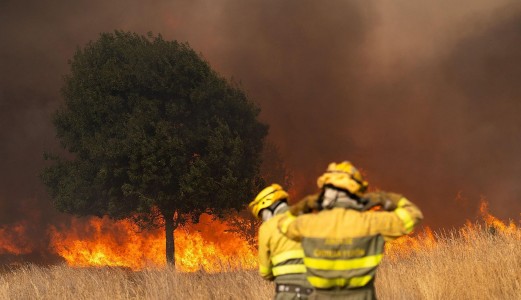In recent months, Europe has experienced a worrying drought that has affected several regions, with important implications on vegetation in terms of water stress and a worsening of fire behaviour when it comes to wildfires. With the idea of gaining a better understanding of this situation, and to keep us up to date at Vallfirest, we have taken advantage of the interview made by our colleagues at The Emergency Program with Brian Verhoeven, meteorologist and researcher at the Netherlands Institute for Public Safety (NIPV), which sheds some light on the issue.
Firstly, following the views of many meteorologists and researchers, Verhoeven argues that the drought affecting Europe paints a worrying picture. The conditions of a notable absence of precipitation persist and intensify beyond a single summer, de-seasonalising wildfires and generating water stress in vegetation that accumulates year after year.

Sentinel 2 images for the same site but from three successive years, comparing the water levels in the Ter river and the Sau reservoir, in Catalonia.
On the other hand, Brian emphasises the importance of the quality, not just the quantity, of rainfall. That is, there is a significant difference between the passage of a frontal zone, where precipitation lasts for many hours with relatively low intensity, and the same amount of precipitation falling in a very short period of time. The second scenario is where the precipitation intensity exceeds the infiltration capacity of the soil, and a large proportion of the water is transported to rivers and therefore of little use to the vegetation. It is therefore necessary to look further than the number of litres accumulated in an area and observe how they are distributed over time.
El Niño, a phenomenon characterised by unusual warming of the Pacific Ocean surface in the equatorial region, but which can lead to changes in weather patterns around the world, comes into play. While South American countries will certainly suffer the most severe consequences, Europe will not be spared. During the El Niño event, warm water in the tropical Pacific releases heat into the atmosphere, which increases the global temperature and can have direct consequences on fire behaviour. In addition, the additional heat and lack of rainfall can increase the evaporation of water from soils and vegetation, reducing humidity and increasing dryness. This creates conditions favourable for the rapid spread of wildfires, as vegetation becomes more vulnerable to any kind of ignition. Changes in rainfall patterns are also observed, with some regions experiencing more intense and frequent rainfall, while others face prolonged droughts. Notably, the rapid growth of fine fuel with heavy rainfall, which can subsequently become dry fuel and act as an initial propagator of any ignition, is also observed.

Comparison of the two contrasting situations that usually occur in Europe. From the anomaly in the FWI danger index, the drastic change in the meteorological conditions for each region is intuited, leading these sites to a very high and even extreme degree of danger. Source: FWI anomaly, GWIS.
However, the Dutch meteorologist is cautious about the influence of El Niño on fire behaviour and says that it should be seen as an additional condition contributing to a rising trend in global temperature. Ultimately, the complexity of climate and its impacts lies in the combination of many factors and its effects must be assessed over time.

Global and European monthly average anomalies. In the latter, although in the north, the temperature was 2.1°C colder, in other places the warmest May was observed among the records of the period considered. Source: Surface air temperature for May 2023, Copernicus).
Undoubtedly, meteorologists, scientists and wildland firefighters all agree on what we have stated above: changes in climate lead to changes in ecosystems and one of the ways in which this manifests itself is wildfires. We are facing an uncertain future, but with tendencies towards more extreme conditions, more intense and faster spreading wildfires. Woodlands must be prepared, and firefighters must be well equipped to face long days of both suppression and prevention efforts.
The challenge faced by firefighting services is enormous, as is the challenge we face in providing safe and effective solutions for everyone involved. At Vallfirest, we feed off this continuous flow of information and knowledge to develop innovative solutions adapted to each fire service.






